You see five burners on that new induction cooktop and range. So this Thanksgiving (or add your favorite holiday here) you cook on all five burners.
That's when you realize the burners don’t heat the same.
Most cooktops will siphon power from other burners.
Some do not.
You will learn which brands do either so you can choose the right induction cooktop for your kitchen.
We will look at induction cooking, how it works, and how it responds.
Looking for answers about Induction Cooking?
Short on time? Download our free Induction Cooking Buying Guide.
What Is Induction Cooking?
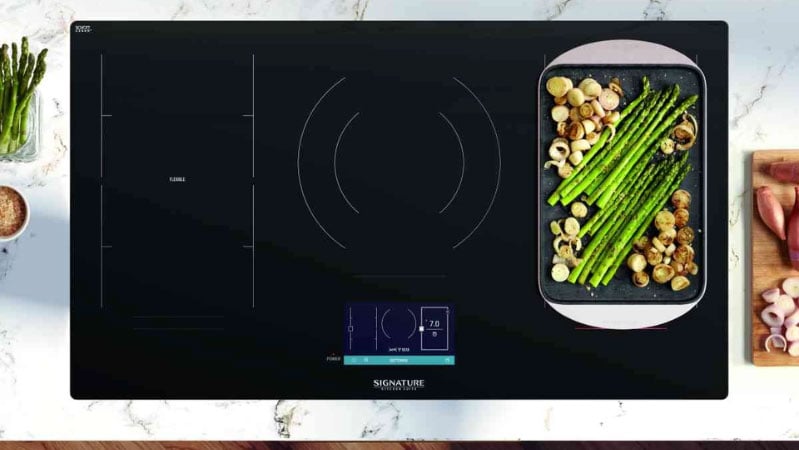
Induction is magnetic heat. The magnet excites the molecules of the pan to cook your food.
Unlike electric cooktops, heat is not transferred through the glass. The pan effectively becomes the burner.

Induction is the fastest and most responsive cooking method available, offering an infinite low simmer.
It is also the most child-safe option because a metal pan is needed to activate the burner.
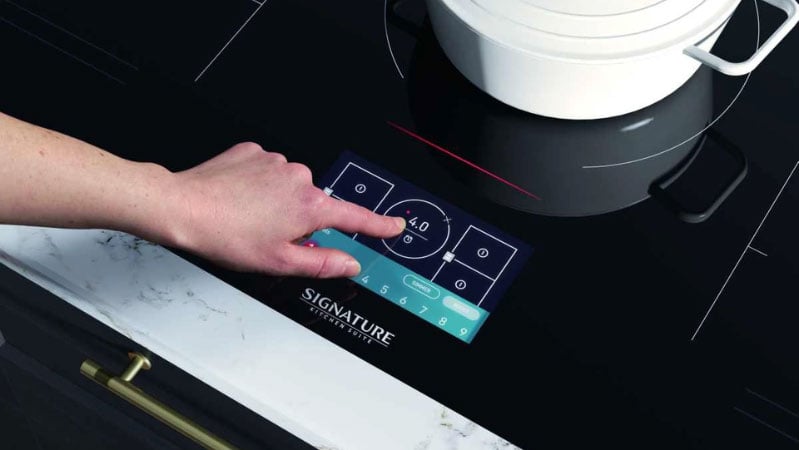
You also have less chance of burning yourself since the glass doesn’t heat up like it does with electric.
However, child-safe doesn’t mean child-proof—the pan still leaves residual heat on the glass.
Induction is 30% more efficient than gas, making it much easier to vent.
Read More: Induction vs. Gas Cooking: A Quick Guide to the Pros and Many Cons of Both
How Power Sharing and Power Boost Impact Induction Cooktop Performance
Power Share
A 36” cooktop has 3 cooking zones, while a 30” cooktop has 2 cooking zones. Let's take a look at a 36-inch induction cooktop from Café Appliances as an example.
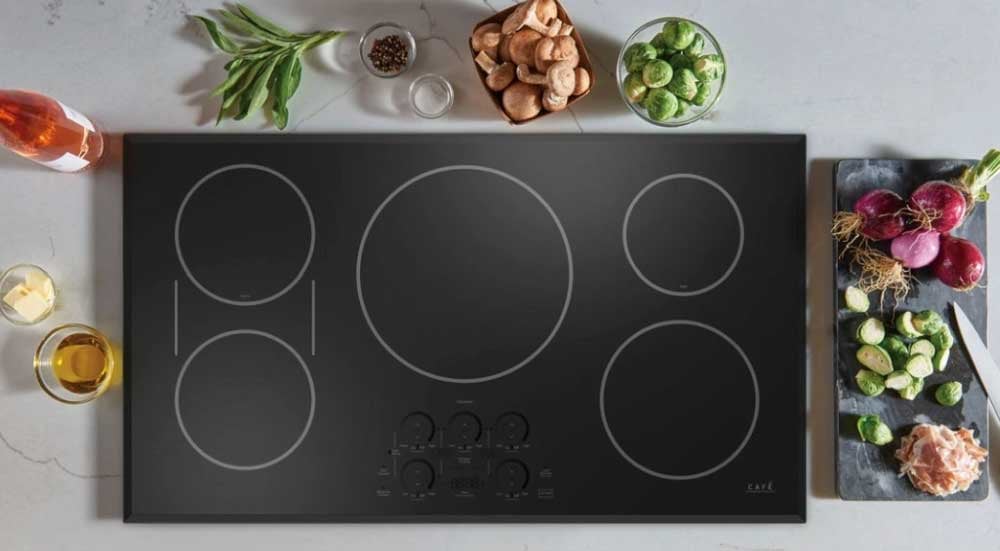
When two elements in the same zone are in use and one is set to maximum power share or power flex (manufacturers use different terms), the other burner will operate at a reduced power level.
.jpg?width=588&height=563&name=Cafe-Appliances-Induction-Cooktop-Controls-(1).jpg) Brands like Wolf, GE, Café Appliances, and many other induction cooktops work with power share. Keep in mind, the display will not indicate this change.
Brands like Wolf, GE, Café Appliances, and many other induction cooktops work with power share. Keep in mind, the display will not indicate this change.
Power is shared between two elements within the same cooking zone.
When you power share, you can transfer some power from an adjacent zone (burner).
One of the burners will become more powerful, which you’ll notice in the max output listed for that burner.
However, the other burner will cycle to a lower output.
Power Boost

Another method of sharing power is called power boost.
This method is used by Bosch, Gaggenau, Thermador, and Miele.
The major difference between power sharing and power boost is that with power sharing, you still have some power in the shared zone.
With a power boost, all the power is removed from the adjacent zone.
Below is an image of a Thermador cooktop showing the different zones.

In this image, zone 1 could boost zone 2, and zone 4 could boost zone 5, or vice versa.
Zone 3 would get a boost from zones 6 and 7.
In this example, zone 2’s highest wattage is 2,200 watts. When you power boost it with zone 1, it increases to 3,600 watts.
Power Boost vs. Power Share
If it’s hard to understand, think of Power Share like a gas cooktop with powerful front burners and smaller ones in the back.
Miele is an exception, as they have twin boosters with two settings, allowing you to have both.
On a 36-inch cooktop, you have three flexible zones.
Like power share, level 1 will take most of the power, still allowing a low temperature on the other burner, similar to Wolf.
Flex level 2 is like a power boost, where you can siphon all the power from an adjacent burner, like Thermador.
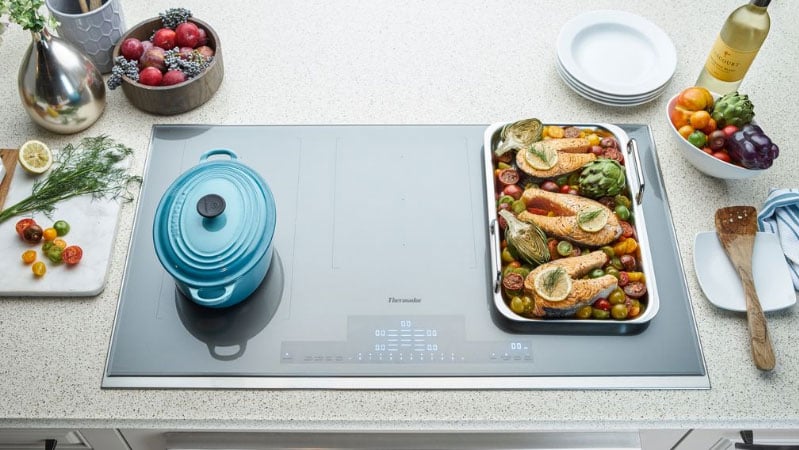
The highest power cooktops will be those with power boost.
So, if you need to bring water to a boil quickly or do a lot of searing and only use a few pans, Power Boost is the best option.
If you cook a lot and use three or more pans at the same time, power share will be better because you can still cook on the adjacent burners.
Key Takeaways

Choosing the right induction cooktop depends on how you like to cook.
If you use several pans at once, power share lets you cook on nearby burners, but with a little less power.
If you care more about speed and high heat for boiling or searing, power boost is a better option. It sends all the power to one burner for maximum heat.
Both options give you the benefits of induction cooking—better control, faster cooking, and more safety than other cooktops.
With the right features, you'll have an easier time cooking, whether it's for a big holiday meal or a quick weeknight dinner.
Additional Resources
Want to know the best induction brands and products and have a better understanding of how induction works? Download the Yale Induction Cooking Buying Guide with features, specs, and inside buying tips. Over 1 million people have read a Yale Guide.
Related Articles
Why Should You Trust Us?
It seems that every appliance review has nothing but glowing comments about almost every product, yet you read customer reviews and they are almost universally bad.
We are here to fill in the disconnect. We'll give you the best features, and the drawbacks as well, including reliability based on over 37,000 calls performed by our service team just last year. Our goal is to give you ALL the information so you know what's right for you.
Please consider subscribing or adding to the conversation in the comments below. We appreciate you stopping by.


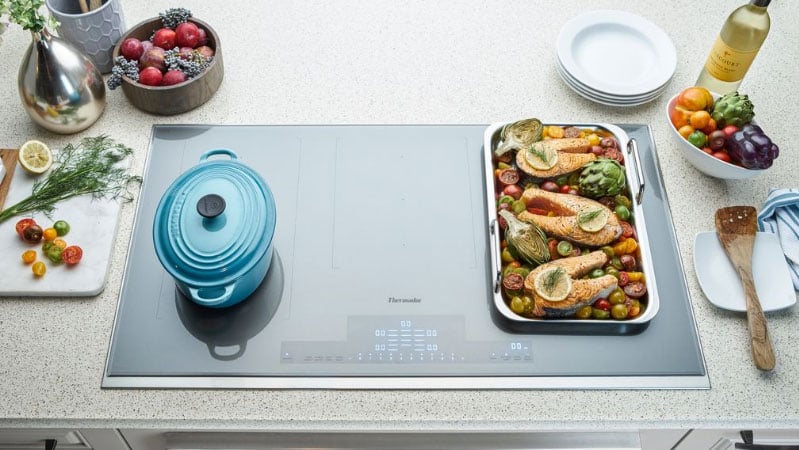




.jpg?width=588&height=563&name=Cafe-Appliances-Induction-Cooktop-Controls-(1).jpg)




